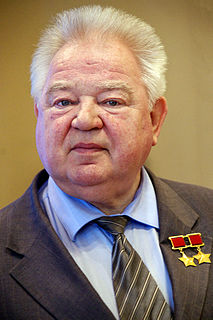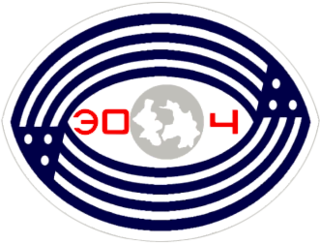
Mir was a space station that operated in low Earth orbit from 1986 to 2001, operated by the Soviet Union and later by Russia. Mir was the first modular space station and was assembled in orbit from 1986 to 1996. It had a greater mass than any previous spacecraft. At the time it was the largest artificial satellite in orbit, succeeded by the International Space Station (ISS) after Mir's orbit decayed. The station served as a microgravity research laboratory in which crews conducted experiments in biology, human biology, physics, astronomy, meteorology, and spacecraft systems with a goal of developing technologies required for permanent occupation of space.

The Salyut programme was the first space station programme, undertaken by the Soviet Union. It involved a series of four crewed scientific research space stations and two crewed military reconnaissance space stations over a period of 15 years, from 1971 to 1986. Two other Salyut launches failed. In one respect, Salyut had the task of carrying out long-term research into the problems of living in space and a variety of astronomical, biological and Earth-resources experiments, and on the other hand the USSR used this civilian programme as a cover for the highly secretive military Almaz stations, which flew under the Salyut designation. Salyut 1, the first station in the programme, became the world's first crewed space station.

Salyut 5, also known as OPS-3, was a Soviet space station. Launched in 1976 as part of the Salyut programme, it was the third and last Almaz space station to be launched for the Soviet military. Two Soyuz missions visited the station, each manned by two cosmonauts. A third Soyuz mission attempted to visit the station, but failed to dock, whilst a fourth mission was planned but never launched.

Salyut 6, DOS-5, was a Soviet orbital space station, the eighth station of the Salyut programme. It was launched on 29 September 1977 by a Proton rocket. Salyut 6 was the first space station to receive large numbers of crewed and uncrewed spacecraft for human habitation, crew transfer, international participation and resupply, establishing precedents for station life and operations which were enhanced on Mir and the International Space Station.

Salyut 7 was a space station in low Earth orbit from April 1982 to February 1991. It was first crewed in May 1982 with two crew via Soyuz T-5, and last visited in June 1986, by Soyuz T-15. Various crew and modules were used over its lifetime, including 12 crewed and 15 uncrewed launches in total. Supporting spacecraft included the Soyuz T, Progress, and TKS spacecraft.

Soyuz 29 was a 1978 crewed Soviet space mission to the Salyut 6 space station. It was the fifth mission, the fourth successful docking, and the second long-duration crew for the orbiting station. Commander Vladimir Kovalyonok and flight engineer Aleksandr Ivanchenkov established a new space-endurance record of 139 days.

Georgy Mikhaylovich Grechko was a Soviet cosmonaut. He flew to space on three missions, each bound for rendezvous with a different Salyut space station. Soyuz 17 was the first crewed vehicle to visit Salyut 4, Soyuz 26 was the first crewed vehicle to visit Salyut 6, and Soyuz T-14 visited Salyut 7. During the latter mission, Grechko helped to relieve the crew of Soyuz T-13, who had repaired damage to the station.

Soyuz 28 was a 1978 Soviet crewed mission to the orbiting Salyut 6 space station. It was the fourth mission to the station, the third successful docking, and the second visit to the resident crew launched in Soyuz 26.

Gennady Mikhailovich Strekalov, 26 October 1940 – 25 December 2004, was an engineer, cosmonaut, and administrator at Russian aerospace firm RSC Energia. He flew into space five times and lived aboard the Salyut 6, Salyut 7, and Mir space stations, spending over 268 days in space. The catastrophic explosion of a Soyuz rocket in 1983 led to him being one of only four people to use a launch escape system. He was decorated twice as Hero of the Soviet Union.

Soyuz T-12 was the seventh crewed spaceflight to the Soviet space station Salyut 7. The name "Soyuz T-12" is also the name of the spacecraft used to launch and land the mission's three-person crew. The mission occurred in July 1984, during the long-duration expedition Salyut 7 EO-3. During the mission, crew member Svetlana Savitskaya became the first woman to ever perform a spacewalk, and the potential Buran Space shuttle pilot, Igor Volk, was given spaceflight experience. Unlike many Soyuz visiting missions, the Soyuz lifeboats were not swapped, and the crew returned to Earth in the same spacecraft in which they launched.

Soyuz T-15 was a crewed mission to the Mir and Salyut 7 space stations and was part of the Soyuz programme. It marked the final flight of the Soyuz-T spacecraft, the third generation Soyuz spacecraft, which had been in service for seven years from 1979 to 1986. This mission marked the first time that a spacecraft visited, and docked with, two space stations in the same mission.

Soyuz TM-2 was the spacecraft used to launch a long duration crew to the Soviet space station Mir, which was uncrewed at the time. TM-2 was launched in February 1987, and it was first crewed spaceflight of the Soyuz-TM spacecraft, and the second crewed spaceflight to Mir. The crew of the long duration expedition, Mir EO-2, who were launched by TM-2 consisted of Soviet cosmonauts Yuri Romanenko and Aleksandr Laveykin.

Progress 1, was a Soviet unmanned Progress cargo spacecraft which was launched in 1978 to resupply the Salyut 6 space station. It was the maiden flight of the Progress spacecraft, and used the Progress 7K-TG configuration. It carried supplies for the EO-1 crew aboard Salyut 6, which consisted of Soviet cosmonauts Yuri Romanenko and Georgy Grechko. The cargo carried by Progress 1 also included equipment for conducting scientific research, and fuel for adjusting the station's orbit and performing manoeuvres.

Yuri Viktorovich Romanenko is a former Soviet cosmonaut, twice Hero of the Soviet Union. Over his career, Yuri Romanenko spent a total of 430 days 20 hours 21 minutes 30 seconds in space and 18 hours in space walks. In 1987 he was a resident of the Mir space station, launching on Soyuz TM-2 and landing aboard Soyuz TM-3. He remained on Mir for 326 days that was the longest stay in space at that time. His son, Roman Romanenko is also a cosmonaut, and has become the third second-generation space traveler on Soyuz TMA-15 in May 2009.

Mir EO-4 was the fourth long-duration expedition to the Soviet space station Mir. The expedition began in November 1988, when crew members Commander Aleksandr Volkov and Flight Engineer Sergei Krikalev arrived at the station via the spacecraft Soyuz TM-7. The third crew member of EO-4, Valeri Polyakov, was already aboard Mir, having arrived in August 1988 part way through the previous expedition, Mir EO-3.

Progress 2 was an unmanned Progress cargo spacecraft launched by the Soviet Union in 1978 to resupply the Salyut 6 space station. It used the Progress 7K-TG configuration, and was the second Progress mission to Salyut 6. It carried supplies for the EO-2 crew aboard Salyut 6, as well as equipment for conducting scientific research, and fuel for adjusting the station's orbit and performing manoeuvres.
Soyuz 6 EP-1 was a 1978 Soviet crewed space flight to the orbiting Salyut 6 space station, during the expedition EO-1. It was the third crewed flight to the station, and the second successful docking. It was also the first crew to visit an occupied station and marked the first time that three spacecraft were docked together. The launching spacecraft was Soyuz 27, and the crew of EP-1 are often referred to as the Soyuz 27 crew.

Mir EO-2 was the second long duration expedition to the Soviet space station Mir, and it lasted from February to December 1987. The mission was divided into two parts, the division occurring when one of the two crew members, Aleksandr Laveykin, was replaced part way through the mission by Aleksandr Aleksandrov. Laveykin was replaced because ground-based doctors had diagnosed him with minor heart problems.

Mir EO-19 was the nineteenth crewed expedition to the space station Mir, lasting from June to September 1995. The crew, consisting of Russian cosmonauts Anatoly Solovyev and Nikolai Budarin, launched on June 27, 1995 aboard the Space Shuttle Atlantis on the STS-71 mission. After remaining aboard Mir for approximately 75 days, Solovyev and Budarin returned aboard the Soyuz TM-21 spacecraft on September 11, 1995.

Progress 3 was an unmanned Progress cargo spacecraft launched by the Soviet Union in 1978 to resupply the Salyut 6 space station. It used the Progress 7K-TG configuration, and was the third Progress mission to Salyut 6. It carried supplies for the EO-2 crew aboard Salyut 6, as well as equipment for conducting scientific research, and fuel for adjusting the station's orbit and performing manoeuvres.



















